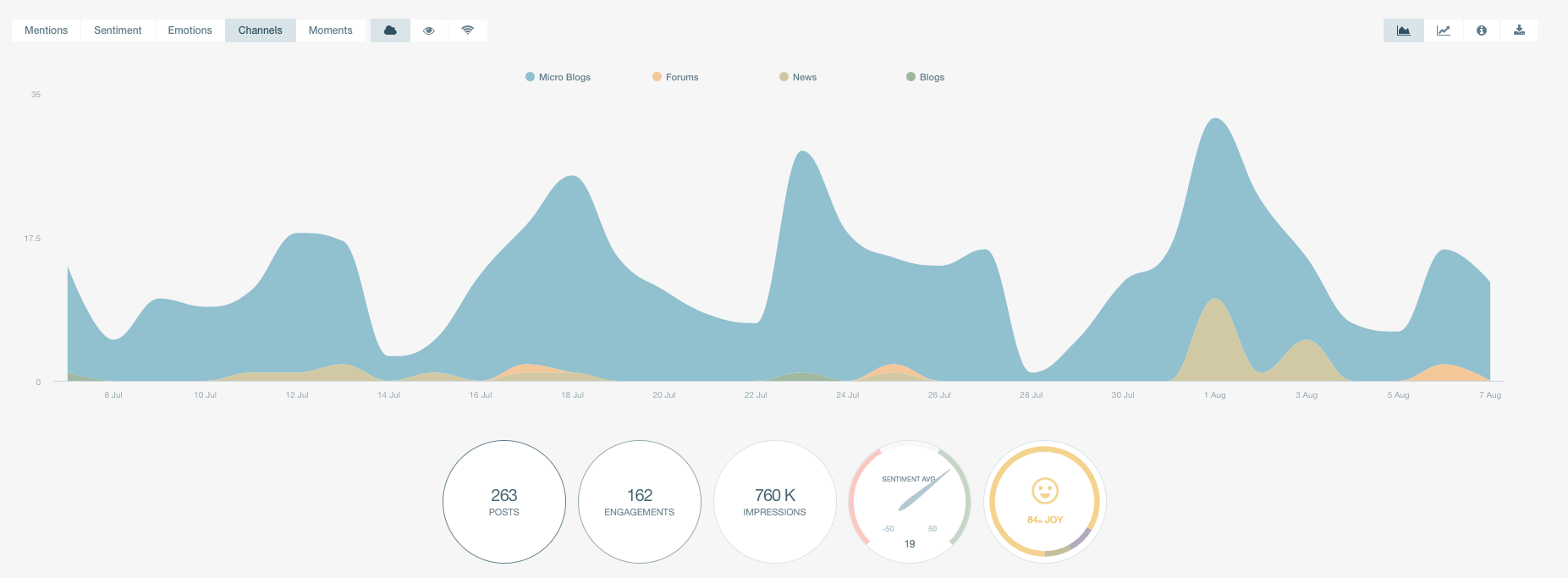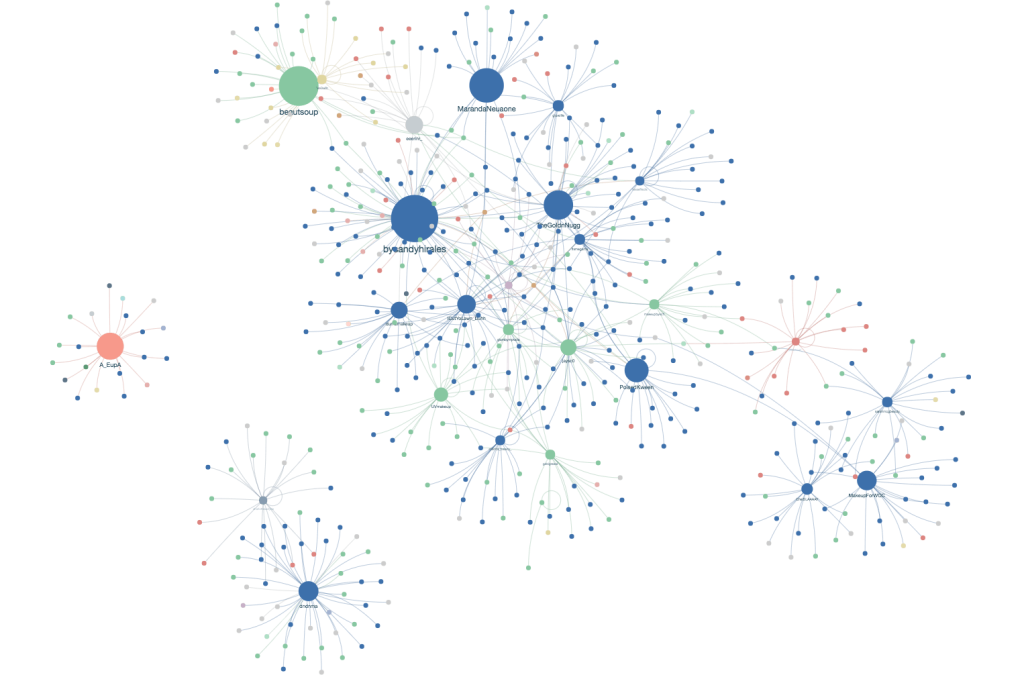What is Brand Monitoring? Top Brand Monitoring Tools & Techniques
- Brand monitoring is a business process to strategically and proactively monitor the reputation, growth and topics associated with a brand or set of brands.
- Day-to-day, brand monitoring consists in discovering, reporting, and reacting to the different conversations and coverage happening around the brand: it can be done “manually” or through a set of dedicated tools (spoiler alert: our own tools Pulsar CORE and Pulsar TRAC are excellent).
- Those brand monitoring tools, which we will focus on in this article, allow you to track online content like articles, web pages, blogs, forums and social media channels allow brand monitoring professionals to get a 360° view of what (and when) is being said about your brand, a competitor’s, or (if you are an agency) a client’s brand.
Channels monitored may include: search engine results, content and links from other websites or social media buzz.

Table of Contents
What are the benefits of brand monitoring?
- Brand monitoring can help you identify how your brand is being spoken about
- Spot negative sentiment surrounding your brand or plagiarism or rights infringements being made
- Use insights about how your brand is perceived to aid development of new product, services or goods
- Address consumer reaction to yours or your competitor’s brand including crisis management
Gain knowledge about how both your brand and competitor brands are being perceived on different platforms - Understand the audience discussing both your brand and category to plan marketing and communication strategies
Brand monitoring is also used for a wider range of activities including market research to put together information and insights into what is being said on topics, keywords or events in your industry. For instance, using Pulsar’s platform you can use our solution CORE to monitor your own brands and get advanced analytics and insights with your owned channels. Compare your channels with your competitors’ as well as finding out the industry average. Pulsar CORE allows you to leverage the power of AI and data visualization to get a deeper understanding of what pieces of content work best on which social media platforms.
Additionally, you can set up historical or recurring searches using our solution TRAC, to continuously monitor conversations online around a topic, phrase, accounts, web pages or events. Then dig deeper into the profile of the audience driving the conversations; the key moments when they communicate; and the language and behaviors used by these audience segments in these posts. Through these insights, you can drive better strategies for marketing, customer relations and advertising campaigns.
What can I monitor?
Branded Keywords
The first thing to starting tracking and monitoring is your own brand or your client’s brand. To set this up the key is to track your brand name but also any other iterations and variations like acronyms, misspellings and common phrases that include your brand’s name (particularly if it’s a word that can be used in a different context) and a description. This can be something like Pulsar, Pulsar Platform, Pulsar, Pulsar brand monitoring etc.
Topics and industry trends
Here you should be monitoring the big picture view of the topic you’re looking to cover. Start searching for key topics associated with your brand. Here you will get insights around what phrases your audience used to talk about key topics in your industry. This way you’ll start to note trends, which can help your content and marketing campaigns.
Here we can get really clever and start looking at web search and your website’s analytics to understand this even more clearly. For instance, in Pulsar TRAC you can use the same search phrases to see what volume of people are searching for these using search engines. Additionally, you can understand which phrases are driving traffic to your website by plugging in your Google Analytics to Pulsar CORE. If you’re not using Pulsar then you can do some manual work and search for the phrases using Google Trends and look at your Google Analytics dashboard.
Influencers and industry micro-influencers
While the world of influencers is rapidly becoming heavily saturated, micro-influencers – generally defined as individuals with between 1000 and 10,000 followers on a social media platform, who speak to a specific audience on a specific niche – can be very important to individual brand strategies, because they both exemplify and influence the behaviour of a typical member of a segment of your audience. This makes micro-influencer audience panels ideal for product planning and testing content. By using brand monitoring tools to hone in conversations happening around your service, you can look to identify micro-influencers. Here’s an educational webinar around the topic.

What brand monitoring campaigns should I set up?
As we’ve briefly covered, there’s a lot you can do with brand monitoring. Here are a few suggested campaigns to run brand monitoring for:
Audience Intelligence
Static methods of marketing to audiences look at age, gender and geography to segment consumers have become the norm in digital marketing, with consumers who don’t fit those segments disregarded. These missed potential consumers are known as “valuable wastage”. However, this method of targeting can miss out on many potential customers of the brand throughout advertising campaigns.
Enter audience marketing, which takes a different approach to target. This is a methodology looking at the psychographics of people within these demographics, such as behaviors, perceptions and mindsets, and targets them according to those characteristics rather than the more generic demographics. For instance, if two people in different demographics show similar behavior and mindsets which are right for the campaign, they should be included in the targeting and not just discarded based on age alone.
Reputation Management
Reputation management is one of the primary use cases for brand monitoring and helps marketing, communications, PR and public affairs teams to proactively monitor a brand’s health, keep an eye on associated conversations or news stories around their products, services, industries, and be quick to react to any situation – negative or positive – that may affect their reputation.
For example, if you owned a hotel, using social listening tools to proactively look out for reviews of your hotel on a booking site, or a news story that has named your brand as one of the rising stars of the sector mean you will always be tune with how your demographic is talking about the company.
One way of doing this using Pulsar TRAC is to look at web search data and correlate that with how your brand is being talked about on social and news sites. This will provide a more holistic view of how people really think about and react to your brand. Does a big social spike provide web traffic? Will people post when you release a new product on your website? There are also plenty of tools to help you tap into various data sources. Use Facebook Business Pages to set up your company’s profile online where users can leave reviews. Also, don’t forget to set up Google Alerts to help you get notifications about new pages that Google finds on the web with your keyword.
Sentiment Analysis
In the previous two use cases, we’ve tapped into audience segments and uncovered demographics. We’ve also covered the method of listening to your audience to see how they talk about your brand or industry topics.
With sentiment analysis – part of your social listening and audience intelligence solution, you will be able to tap into the emotion behind these conversations. Through AI and Natural Language Processing (NLP), platforms are able to analyze online conversations from forums to social media and news sites to provide insights into the feelings of the selected audience segment or conversation around the topic.

Sentiment analysis can be deployed to cover real-time content and conversations or tap into historical segments., For example you can set up a search to see how a specific audience segment felt and spoke about a music festival last year and use this insight as a benchmark or hypothesis for setting a real-time search.
Content Creation and Copywriting
When it comes to advertising, marketing and PR, you’re probably aware how smart content creation and the use of compelling copy can help your brand communicate to your audience in an engaging way.
By using brand monitoring, you can proactively keep an eye on and seek out associated topics and trends happening within your industry that your potential customers care about. This can fuel your content creation. By delving deeper into these conversations, you can surface the terminology and phrases used by your target audience to really start speaking their language.
Competitor Benchmarking & Analysis
As part of brand monitoring, you can look to measure the performance of your marketing and advertising by measuring the amount of mentions you’ve had on a channel, or how many new web domains covered the latest story about your new product release. Then you can group your brand and competitors and measure your success versus a benchmark.
Additionally, you can keep an eye on the growth of your channels and see what kind of audience you’re attracting, their demographics, behaviors and affinities.
Some more advanced social brand monitoring tools, such as Pulsar CORE, use AI to understand how your content is performing. This way you can identify the best creative, and understand the most engaging keywords in your copy, and which formats – image, link, video – work best on which social media channel.
Brand monitoring tools
Medium to large and enterprise-size organisations and agencies tend to use brand monitoring platforms such as Pulsar, which has multiple tools which work seamlessly alongside one other such as social media research, trend tracking and image analysis. However, if you’re looking to just start out with brand monitoring, there also a lot of free tools which can get you started. We’ve mentioned some of them in the post, however, you can find some others here:
Google Alerts
Free and easy, just add a keyword in and you’ll receive emails when someone uses it on the web. You can use it to track anything from your brand name to currencies, meaning it’s pretty versatile. It is basic though, just offering up the mentions with no analysis or long-term overviews.
Google Marketing Platform
Google has a host of other tools and services – which are available for free – that will help you with brand monitoring, web analytics and optimisation. These tools have now been brought under one umbrella. Through its Data Studio you can create dashboards that will help you visualise your web and search console data.
Google Analytics and Search Console are must-have tools to see which channels bring visitors to your website, which phrases they use to get there, and how the behave once they’re on it.
Backlink Checker
To understand how your brand, products and services are being talked about, another method of brand monitoring is to see which websites are linking to your own website. Creating a series of backlinks to your website from reputable sites is crucial, especially when it comes to search engine optimization. There are a number of paid tools which are part of wider search optimization platforms. However, you can get started with a free tool like Backlink Checker.
Social Mention
Using comprehensive platforms like Pulsar gives users the ability to really dig into topics and phrases people are talking about across the web and on social. Tools like Pulsar TRENDS help to identify the peaks and troughs of trends on social in real-time, or going back up to 12 years. However, if you want to have some of these functionalities for free, there’s Socialmention.com. Here, you get a quick breakdown of a phrase, where it’s used and a quick view of the post it is mentioned in. Its limitations lie with multi-word phrases which are hard to track, however it can be a good tool to have in your arsenal.
Pulsar
We almost forgot to mention. Pulsar is a comprehensive platform and brand monitoring tool that encompasses several different solutions that help you understand your audience, the conversations they’re having and how your campaigns are performing across the web. Pulsar’s audience intelligence platform allows for brand monitoring, social listening and helps small to large companies spot trends before they occur, create panels of micro-influencers and create benchmarks so you can compare how well you’re doing against the industry.

